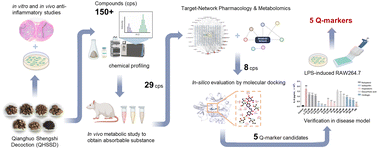A Q-marker screening strategy based on ADME studies and systems biology for Chinese herbal medicine, taking Qianghuo Shengshi decoction in treating rheumatoid arthritis as an example†
Abstract
Chinese herbal medicine (CHM) exhibits a broad spectrum of clinical applications and demonstrates favorable therapeutic efficacy. Nonetheless, elucidating the underlying mechanism of action (MOA) of CHM in disease treatment remains a formidable task due to its inherent characteristics of multi-level, multi-linked, and multi-dimensional non-linear synergistic actions. In recent years, the concept of a Quality marker (Q-marker) proposed by Liu et al. has significantly contributed to the monitoring and evaluation of CHM products, thereby fostering the advancement of CHM research. Within this study, a Q-marker screening strategy for CHM formulas has been introduced, particularly emphasising efficacy and biological activities, integrating absorption, distribution, metabolism, and excretion (ADME) studies, systems biology, and experimental verification. As an illustrative case, the Q-marker screening of Qianghuo Shengshi decoction (QHSSD) for treating rheumatoid arthritis (RA) has been conducted. Consequently, from a pool of 159 compounds within QHSSD, five Q-markers exhibiting significant in vitro anti-inflammatory effects have been identified. These Q-markers encompass notopterol, isoliquiritin, imperatorin, cimifugin, and glycyrrhizic acid. Furthermore, by employing an integrated analysis of network pharmacology and metabolomics, several instructive insights into pharmacological mechanisms have been gleaned. This includes the identification of key targets and pathways through which QHSSD exerts its crucial roles in the treatment of RA. Notably, the inhibitory effect of QHSSD on AKT1 and MAPK3 activation has been validated through western blot analysis, underscoring its potential to mitigate RA-related inflammatory responses. In summary, this research demonstrates the proposed strategy's feasibility and provides a practical reference model for the systematic investigation of CHM formulas.



 Please wait while we load your content...
Please wait while we load your content...